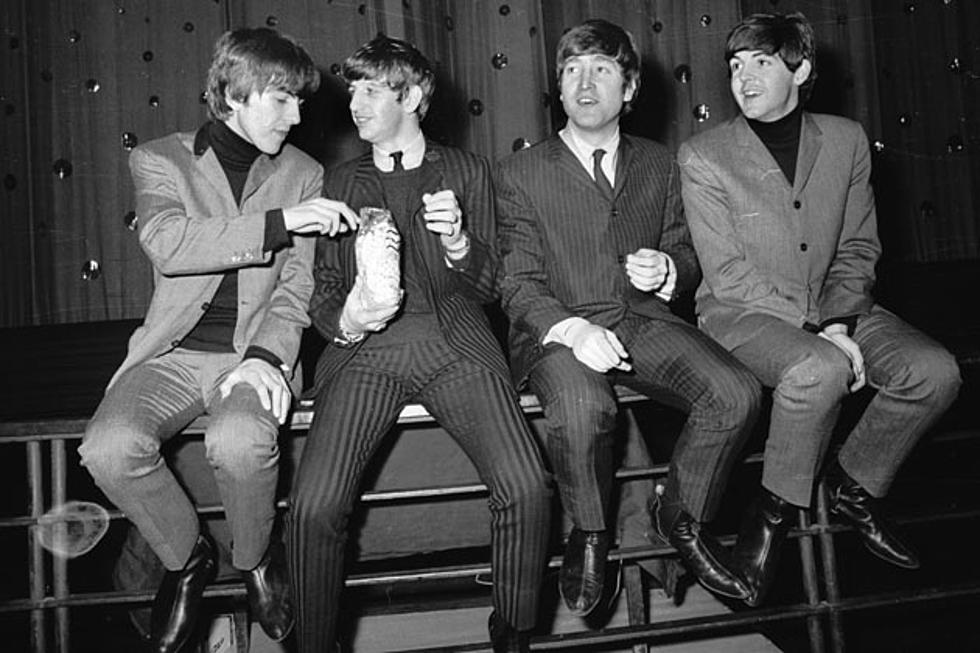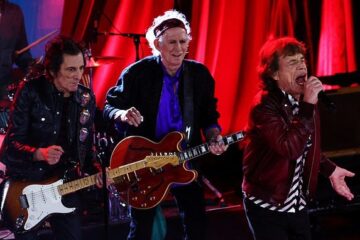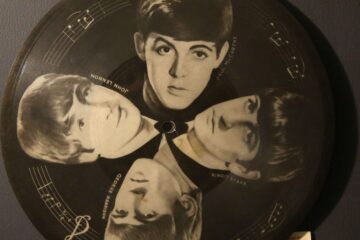The Beatles was a coming together of four incredible creative forces. Even though John Lennon and Paul McCartney have gone down in history as the greatest songwriting duo of all time, it would be wrong to ignore the contributions of George Harrison and Ringo Starr in shaping the band’s legacy.
All four members brought something so distinct and important. Lennon’s lyrical prowess gave us tracks like ‘A Hard Day’s Night’, ‘Norwegian Wood’ and ‘Across The Universe’. McCartney, meanwhile, is a master of melodies and writing timeless anthems like ‘Let It Be’ and ‘Yesterday’. The world has George Harrison to thank for ‘Here Comes The Sun’ and the ultimate love song, ‘Something. Even Ringo Starr, despite getting a bad rep for being the weakest link, tried his hand at writing.
“What’s your favourite Beatles song?” is possibly the hardest question to answer. So, while trying to qualify The Beatles’ discography is impossible, we can quantify them. Treating it as nothing but a numbers game, Lennon and McCartney obviously led the way as the writers of most of the band’s songs.
As the band’s relationship changed and evolved with their developing fame and eventual falling out, so did their writing process. What started as quite a collaborative relationship between Lennon and McCartney eventually became increasingly splintered as all the band members began fighting for their spot on album tracklists.
Who wrote the most Beatles songs?
Please Please Me (1963)
John Lennon (5): ‘Please Please Me’, ‘‘Ask Me Why’, ‘There’s a Place,’ ‘Do You Want to Know a Secret’, ‘Misery’.
Paul McCartney (4): ’Love Me Do’, ‘P.S. I Love You’, ‘I Saw Her Standing There’, ‘Misery’.
Famously, The Beatles’ debut was mostly recorded in a single day. The band wasted no time cutting their first album; however, they had plenty of time to prepare for it. The record is a treasure trove of promise, with all the lyrical wit and catchy rhythms that would come to define them. Lennon wins the tracklist race with five songs to McCartney’s four.
Lennon’s fifth song, ‘Do You Want To Know A Secret’, was, however, given away to Harrison to perform. Immediately allowing him to be a third vocalist in the band, the band was always a delicate balancing act of a lot of talented artists.shttps://youtu.be/czw8eqepir8
With The Beatles (1963)
John Lennon (5): ‘It Won’t Be Long’, ‘All I’ve Got to Do’, ‘Not a Second Time’, ‘I Wanna Be Your Man’ and ‘Little Child’.
Paul McCartney (4): ‘All My Loving’, ‘Hold Me Tight’, ‘I Wanna Be Your Man’ and ‘Little Child’.
George Harrison (1): ‘Don’t Bother Me’.
Desperate to continue the hype that their debut album fostered, their sophomore release came only a few months later. Luckily, the band were prolific. Already having a wealth of material ready to be released, they didn’t struggle to fill another tracklist.
Once again, Lennon came out on top as he wrote five tracks, with McCartney only one behind him. The record houses Harrison’s very lyrical attempt as ‘Don’t Bother Me’, an early version of the true rock and roll sound he’d bring to the band.
A Hard Day’s Night (1964)
John Lennon (10): ‘A Hard Day’s Night’, ‘I Should Have Known Better’, ‘Tell Me Why’, ‘If I Fell’, ‘Any Time at All’, ‘You Can’t Do That’, ‘I’m Happy Just to Dance With You’, ‘I’ll Cry Instead’, ‘I’ll Be Back’, ‘When I Get Home’.
Paul McCartney (3): ‘Can’t Buy Me Love’, ‘And I Love Her’, ‘Things We Said Today’.
For their first album, no one else got a look in. Lennon was on an absolute roll as he wrote ten songs for their first motion picture soundtrack. Truly taking his role as the early band leader seriously, there was no slowing him.
While McCartney only wrote three tracks, all of them were hits. Delivering two of his most timeless tracks, ‘Can’t Buy Me Love’ and ‘And I Love Her’ stand out as some of the band’s finest.https://youtu.be/Yjyj8qnqkYI
Beatles For Sale (1964)
Paul McCartney (5): ‘Eight Days a Week’, ‘I’ll Follow the Sun’, ‘Every Little Thing’, ‘What You’re Doing’, ‘Baby’s in Black’.
John Lennon (4): ‘I’m a Loser’, ‘No Reply’, ‘I Don’t Want to Spoil the Party’, ‘Baby’s in Black’.
McCartney wasn’t resting on his laurels in the early days. By the band’s fourth album, he finally ran ahead of his songwriting partner. Finally finding his groove, tracks like ‘Eight Days A Week’ especially defined this era for the group, creating their own fresh rock and roll sound.
Lennon wasn’t far behind, but none of his tracks for this album were really big hits. Harrison seemed to slip back into the background, leading on guitar rather than offering up any lyrics.
Help! (1965)
John Lennon (5): ‘Help!’, ‘Ticket to Ride’, ‘You’ve Got to Hide Your Love Away’, ‘You’re Going to Lose That Girl’, ‘It’s Only Love’.
Paul McCartney (5): ‘Yesterday’, ‘I’ve Just Seen a Face’, ‘The Night Before’, ‘Another Girl’, ‘Tell Me What You See’.
George Harrison (2): ‘I Need You’, ‘You Like Me Too Much’.
Lennon came back with a vengeance on Help!, the band’s second film soundtrack album. McCartney also contributes so many hits, making it one of their finest albums and more defining records. Housing ‘Yesterday’ and ‘Help!’, the musicians were writing anthems in 1965.
Harrison also returned as a songwriter, contributing two worthy tracks that have none of which represented his best work.
This album is significant as it represents a transition in The Beatles’ musical trajectory, showcasing their willingness to explore new musical territories and experiment with different sounds and emotions. It’s a pivotal moment in their career, bridging the gap between their earlier pop-centric albums and the more adventurous and innovative work that would follow in subsequent releases.
Rubber Soul (1965)
John Lennon (8): ‘Norwegian Wood (This Bird Has Flown)’, ‘Nowhere Man’, ‘Girl’, ‘Run for Your Life’, ‘In My Life’, ‘Wait’, ‘What Goes On’, ‘The Word’.
Paul McCartney (8): ‘Drive My Car’, ‘I’m Looking Through You’, ‘Michelle’, ‘You Won’t See Me’, ‘In My Life’, Wait’, ‘What Goes On’, ‘The Word’.
George Harrison (2): ‘If I Needed Someone’, ‘Think for Yourself’.
Ringo Starr (1): ‘What Goes On’.
By 1965, The Beatles’ process changed. Ringo Starr called it their “departure record”, marking a moment of clear change in their sound and style. With no touring or concert commitments, they were able to write and record in a different way, letting the members truly shine. For the first time, all four of the boys contributed songs.
Lennon and McCartney are joint leaders as their collaborative relationship thrived, co-writing four tracks together. Adopting a more folk sound as all members mutually obsessed over Bob Dylan, this was the first moment of clear evolution.
Revolver (1966)
John Lennon (6): ‘Tomorrow Never Knows’, ‘And Your Bird Can Sing’, ‘I’m Only Sleeping’, ‘She Said She Said’, ‘Doctor Robert’, ‘Eleanor Rigby’.
Paul McCartney (6): ‘Good Day Sunshine’, ‘For No One’, ‘Got to Get You Into My Life’, ‘Here, There and Everywhere’, ‘Yellow Submarine’, ‘Eleanor Rigby’.
George Harrison (3): ‘Taxman’, ‘Love You To’, ‘I Want to Tell You’.
As the band’s most obvious use of studio technology and new sounds to date, the album was a further step down the path of experimentation. The group has started diving deep into the world of LSD, leading to the adoption of broader sounds and influences.
However, Revolver was also really the start of the end as in-fighting began to break out, leading to less collaboration between Lennon and McCartney. The pair were head to head with six tracks each, both with their fair share of hits. Harrison came in hot and heavy with a huge opening track as ‘Taxman’ stands as one of his biggest songs for the band.
Sgt. Pepper’s Lonely Hearts Club Band (1967)
Paul McCartney (9): ‘Sgt. Pepper’s Lonely Hearts Club Band’, ‘When I’m 64’, ‘With a Little Help From My Friends’, ‘Fixing a Hole’, ‘Getting Better’, ‘Lovely Rita’, ‘She’s Leaving Home’, ‘Sgt. Pepper’s (Reprise)’, ‘A Day in the Life’.
John Lennon (4): ‘Lucy in the Sky with Diamonds’, ‘Being For the Benefit of Mr. Kite’, ‘Good Morning Good Morning’, ‘A Day in the Life’.
George Harrison (1): ‘Within You Without You’.
The Beatles’ magnum opus on drugs and counterculture, Sgt. Pepper’s Lonely Hearts Club Band is one of the most important and defining records of the 1960s as the Fab Four fully embraced psychedelics. While some tracks might be duds, slipping too far into humour or nonsense, there are some masterpieces.
Lennon and McCartney came together to craft the incredible, ‘A Day in the Life’. But in general, McCartney dominated here. With an open-ended studio session and no deadlines, it seems that the bass player was the one to really get to work.
Magical Mystery Tour (1967)
Paul McCartney (4): ‘Magical Mystery Tour’, ‘The Fool on the Hill’, ‘Your Mother Should Know’, ‘Flying’.
John Lennon (2): ‘I Am the Walrus’, ‘Flying’.
George Harrison (2): ‘Blue Jay Way’, ‘Flying’.
Ringo Starr (1): ‘Flying’.
Magical Mystery Tour was truly a McCartney-led project. Originally released as a double EP in the UK, it was launched as a full album across the pond. Soundtracking another film from the band, it delved deeper into the energy of their previous release.
McCartney ran ahead with the majority of the songs; however, Lennon did contribute the psychedelic anthem, ‘I Am The Walrus’. The release also contains one of the only instances of a song being co-written by all four members.
The Beatles (1968)
John Lennon (13): ‘Revolution 1’, ‘Dear Prudence’, ‘Glass Onion’, ‘Julia’, ‘Cry Baby Cry’, ‘Yer Blues’, ‘Happiness is a Warm Gun’, ‘I’m So Tired’, ‘Sexy Sadie’, ‘Everybody’s Got Something to Hide Except Me and My Monkey’, ‘The Continuing Story of Bungalow Bill’, ‘Revolution 9’, ‘Good Night’.
Paul McCartney (12): ‘Blackbird’, ‘Back in the U.S.S.R.’, ‘I Will’, ‘Martha My Dear’, ‘Mother Nature’s Son’, ‘Birthday’, ‘Honey Pie’, ‘Helter Skelter’, ‘Why Don’t We Do It in the Road?’, ‘Rocky Raccoon’, ‘Ob-La-Di, Ob-La-Da’, ‘Wild Honey Pie’.
George Harrison (4): ‘While My Guitar Gently Weeps’, ‘Savoy Truffle’, ‘Long Long Long’, ‘Piggies’
Ringo Starr (1): ‘Don’t Pass Me By’.
By the time the 1968 The Beatles, or the White Album, rolled around, tensions in the band were high. At one point, Starr even walked out and quit the band for two weeks, so it wasn’t exactly a conducive atmosphere for collaboration. Instead, the band were in a bloody tracklist battle, all demanding their songs be included. Leading to a huge 30-song album, it contains some of their best and some of their worst work.
Lennon and McCartney both demanded inclusion; however, Lennon just crept ahead with one more song. Both of the songwriting duo provided some of the band’s best work in the form of ‘Blackbird’ and ‘Dear Prudence’. But it’s important not to ignore Harrison’s contribution here as he gave the band the masterpiece that is ‘While My Guitar Gently Weeps’, truly coming into his own as their late period secret weapon.
Yellow Submarine (1969)
John Lennon (2): ‘All You Need is Love’, ‘Hey Bulldog’.
Paul McCartney (2): ‘All Together Now’, ‘Hey Bulldog’.
George Harrison (2): ‘It’s All Too Much’, ‘Only a Northern Song’.
As the soundtrack to a new animated film, Yellow Submarine doesn’t really feel like a proper Beatles release. Centered around the previously shared ‘Yellow Submarine’, it is Ringo Starr’s one and only title track as he finally got to sing a lead single.
The release does house one vital piece of Beatles music – ‘All You Need Is Love’. Maybe the ultimate song from the band, Lennon’s timeless love song is written into history.
Abbey Road (1969)
Paul McCartney (8): ‘You Never Give Me Your Money’, ‘She Came in Through the Bathroom Window’, ‘Oh! Darling’, ‘Maxwell’s Silver Hammer’, ‘Golden Slumbers’, ‘Carry That Weight’, ‘The End’, ‘Her Majesty’.
John Lennon: (6): ‘Come Together’, ‘I Want You (She’s So Heavy)’, ‘Sun King’, ‘Mean Mr. Mustard’, ‘Polythene Pam’, ‘Because’.
George Harrison: (3): ‘Something’, ‘Here Comes the Sun’, ‘Octopus’ Garden’.
Ringo Starr (1): ‘Octopus’ Garden’.
Confusingly, Abbey Road was the last album the Beatles ever recorded, but not their final release. Let It Be was recorded earlier in the same year, but Abbey Road, for some reason, was released first, partly due to tensions in the band, tracklist arguments and the hopes for a reunion. By the time Abbey Road was released, the band had split up.
They ended on a high, though, as all four members delivered their finest work. While McCartney raced ahead with the most songs, Harrison undeniably won on quality. Featuring ‘Something’ and ‘Here Comes The Sun’, Harrison gave his best to this record..
Let It Be (1970)
John Lennon (5): ‘Dig a Pony’, ‘One After 909’, ‘Across the Universe’, ‘Dig It’, ‘I’ve Got a Feeling’.
Paul McCartney (5): ‘Get Back’, ‘Let It Be’, ‘Two of Us’, ‘The Long and Winding Road’, ‘I’ve Got a Feeling’.
George Harrison (2): ‘I Me Mine’, ‘For You Blue’.
The final Beatles album ever released. Recorded under tumultuous conditions as the band navigated various arguments, pressures from their team to put on a concert and walkouts from several members. McCartney has dreamt the album up, hoping a return to a more classic rock and roll sound would bring the boys back together. And while sonically it’s a masterpiece, even the best songs couldn’t fix the mood.
Lennon and McCartney tie for first place, while Harrison once again contributes some secret weapon tracks. However, Let It Be is perhaps most interesting as it plants the seasons for the member’s various solo projects. ‘Two Of Us’ would fit nicely on Ram. While ‘I Me Mine’ could easily be an All Things Must Pass track. The boys had clearly moved on from the band, giving it their final efforts.
Other Beatles Releases
John Lennon (20): ‘This Boy’, ‘I Call Your Name’, ‘Yes It Is’, ‘I Feel Fine’, ‘Day Tripper’, ‘Rain’, ‘Strawberry Fields Forever’, ‘Revolution’, ‘Don’t Let Me Down’, ‘The Ballad of John and Yoko’, ‘You Know My Name (Look up the Number)’, ‘Real Love’, ‘She Loves You’, ‘From Me to You’, ‘I Want to Hold Your Hand’, ‘Thank You Girl’, ‘I’ll Get You’, ‘We Can Work It Out’, ‘Baby, You’re a Rich Man’, ‘Free as a Bird’.
Paul McCartney (15): ‘She’s a Woman’, ‘I’m Down’, ‘Paperback Writer’, ‘Penny Lane’, ‘Hello, Goodbye’, ‘Lady Madonna’, ‘Hey Jude’, ‘She Loves You’, ‘From Me to You’, ‘I Want to Hold Your Hand’, ‘Thank You Girl’, ‘I’ll Get You’, ‘We Can Work It Out’, ‘Baby, You’re a Rich Man’, ‘Free as a Bird’
George Harrison (3): ‘The Inner Light’, ‘Old Brown Shoe’, ‘Free as a Bird’.
Ringo Starr (1): ‘Free as a Bird’.
While Paul McCartney wins as the writer of the most album tracks, John Lennon claws back his lead through the singles. As the top writer of the band’s stand-alone tracks and additional B-sides, Lennon was prolific in his own way.
As some of the band’s biggest tracks never got a spot on an album, their singles are still just as worthy as any tracklist spot.
Who wrote the most Beatles songs?
John Lennon: 95
Paul McCartney: 90
George Harrison: 25
Ringo Starr: 5
Who wrote the most number one songs for The Beatles?
It would be wrong to try to qualify who was better, Lennon or McCartney. But the charts have spoken! While both writers contributed huge hits for the band, writing themselves and the band into the history books thanks to their stream of timeless anthems, one of them did come out ahead.
While John Lennon wrote the most songs for the band, Paul McCartney wrote the most number-one hits. By the time the band split, he had penned twenty number-one tracks as the principal songwriter.



